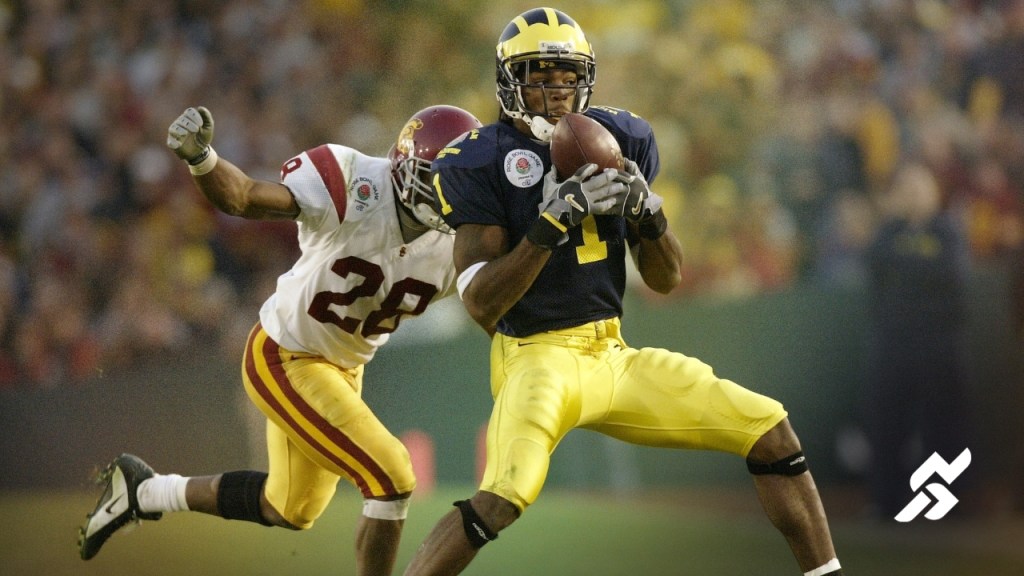A federal judge in Michigan has dismissed an antitrust lawsuit brought by four former Michigan football players—Denard Robinson, Braylon Edwards, Michael Martin and Shawn Crable—who contend they’re owed more than $50 million from the NCAA, Big Ten and Big Ten Network over continued use of their NIL from their college days.
U.S. District Judge Terrence G. Berg’s Sept. 26 ruling comes on the heels of judges in North Carolina, New York and Ohio dismissing similar lawsuits brought by, among others, former NC State forward Thurl Bailey, former Kansas guard Mario Chalmers and former Ohio State quarterback Terrelle Pryor.
The basic problem with these cases is that the former players waited too long to sue.
Antitrust claims have a statute of limitations of four years, and these players haven’t played in college for decades. The math is straightforward. While judges can toll statutes of limitations, in effect suspending the statute to allow litigation, none in the Bailey, Chalmers, Pryor and Robinson cases found sufficient reason to do so.
Robinson, Edwards, Martin and Crable played for the Wolverines between 2001 and 2012. They insist the NCAA and its member institutions, along with the Big Ten and Big Ten Network, violated antitrust laws. These defendants allegedly joined hands through NCAA rules to prevent the players from signing NIL deals. The Michigan players stress their NCAA eligibility hinged on signing a student-athlete statement that denied them the chance to sign NIL deals and granted the NCAA and its members control of their publicity rights.
The players, who can appeal Berg’s order to the U.S. Court of Appeals for the Sixth Circuit, seek for their case to become a class action on behalf of college athletes who played prior to June 15, 2016, and whose NIL has been used in videos and other materials without their consent. That date was selected is the start date for the House settlement, with some NCAA athletes who played after that date eligible for House settlement payments.
Berg noted that the act depicted by the Michigan players as causing them legal harm “occurred at the latest in 2012,” the last year one of them played for the Wolverines. This act was the NCAA requirement the players relinquished control over their publicity rights as a condition of eligibility.
While the four players argue they were harmed after 2012, including by appearing in Michigan highlights and videos, that use, Berg explained, is “not a new and independent act that restarts the statute of limitation.”
Likewise, although the players say they “continue to feel the adverse effects” of giving up their publicity rights, the judge wrote that any damage from these alleged effects would go to potential monetary damages—not the creation of a new, allegedly illegal act.
Berg also wasn’t swayed by the players’ demand that he toll the four-year statute of limitations. The players argued they were “barely at the age of maturity” when they first signed away their publicity rights as freshmen. They also accused the defendants of maintaining “a culture of secrecy and misinformation regarding the commercial use of student-athletes’ NIL.” This “culture” allegedly “obstructed” Robinson, Edwards, Martin and Crable from being able to “to assert their legal rights.”
These arguments didn’t move the needle, in Berg’s view.
The four players failed to “specifically allege” that the NCAA, Big Ten and Big Ten Network “engaged in fraudulent concealment or otherwise secreted or concealed” how they’d use the players’ NIL.
Not only was there no conspiracy to hide, Berg explained, but the players admit they signed NCAA forms detailing how their publicity rights could be used. Berg therefore concluded the players acknowledge “NIL rules were well-known to them.”
The failure of the former players in the Bailey, Chalmers, Pryor and now Robinson cases before four different judges suggests both this type of claim is legally unpersuasive and that the NCAA’s defenses are effective. It will take reversals by appellate courts to demonstrate otherwise.
